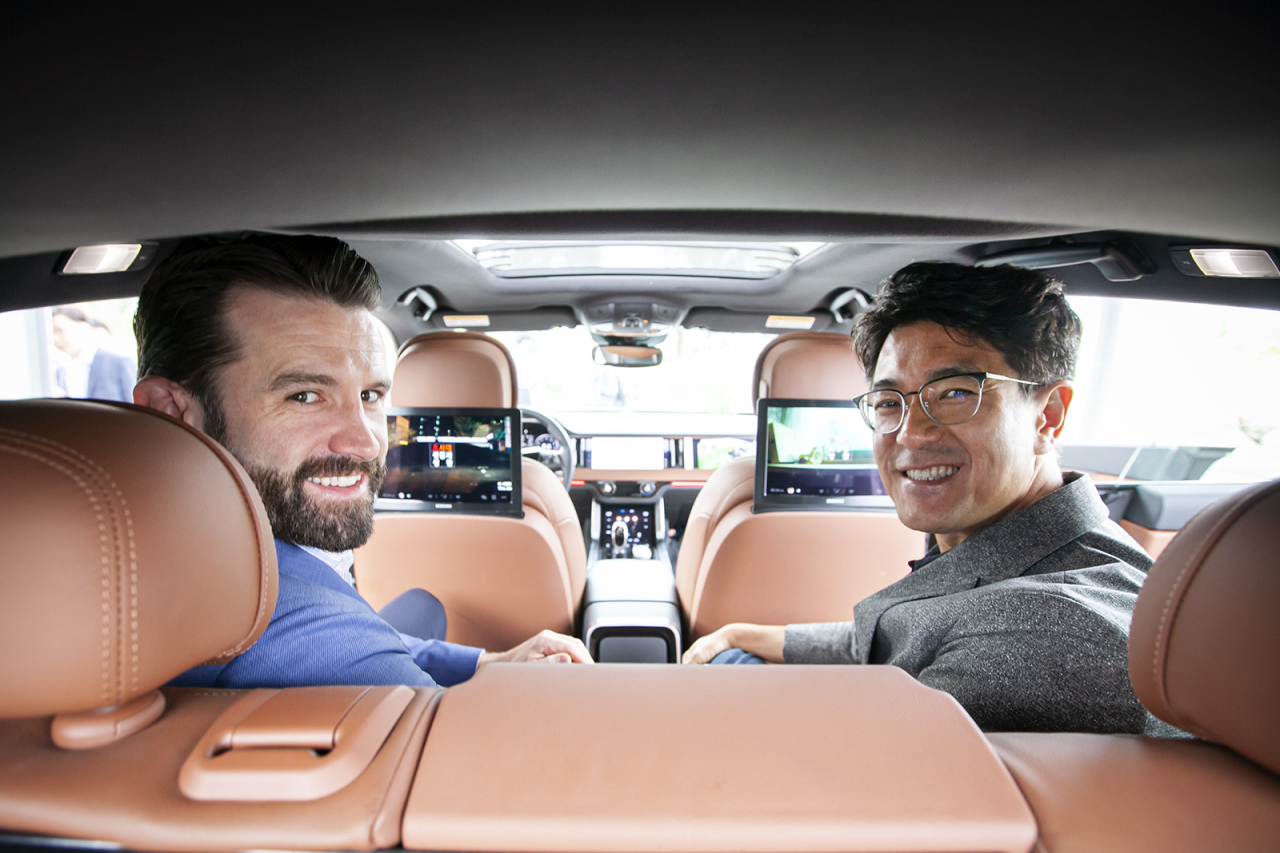SKT teams up with Sinclair on 5G broadcasting in US
Sinclair CEO says joint venture with SKT will launch in “couple of days” in Washington
By Yeo Jun-sukPublished : June 4, 2019 - 18:11
JEJU ISLAND -- A friendly match between US soccer teams was broadcast live on 12-inch screens installed into every seat of a shiny white sport utility vehicle cruising the streets of Korea’s southern Jeju Island.
Broadcast from multiple angles in the stadium, the sporting event was punctuated by personalized TV commercials, streaming different content tailored to each passenger depending on their interests as preregistered with the car.
The futuristic scene was the latest effort by SK Telecom to capitalize on advanced network technology to transform the driving experience. Now the nation’s biggest mobile carrier has set its sights on the US market to expand its technological prowess globally.
“Based on the combination of next-generation telecom and broadcasting technologies, we managed to visualize the in-car media environment in the era of autonomous driving,” SKT said. “It will become a starting point for our entry into the US broadcasting market.”
Broadcast from multiple angles in the stadium, the sporting event was punctuated by personalized TV commercials, streaming different content tailored to each passenger depending on their interests as preregistered with the car.
The futuristic scene was the latest effort by SK Telecom to capitalize on advanced network technology to transform the driving experience. Now the nation’s biggest mobile carrier has set its sights on the US market to expand its technological prowess globally.
“Based on the combination of next-generation telecom and broadcasting technologies, we managed to visualize the in-car media environment in the era of autonomous driving,” SKT said. “It will become a starting point for our entry into the US broadcasting market.”

Along with Sinclair Broadcast Group and automotive service company Harman, the mobile carrier is seeking to build an advanced automotive platform based on the new broadcasting standard for US consumers.
The key factor that enables Sinclair to work with SKT is the new standards for digital television in the US called Advanced Television Systems Committee 3.0, which allows broadcasters to deliver sophisticated contents at a much faster pace.
Two-way communication is also possible for the delivery of tailored contents for targeted consumers. And most importantly for SKT, it is in sync with the Korean version of the high-definition broadcasting system digital standard.
“Spectrum efficiency of ATSC 3.0 is much higher than 4G Long-Term Evolution or 5G broadcast. … So It’s inherently much more efficient distribution system,” Sinclair CEO Christopher Ripley said. “I think it will have high value to the ecosystem because of efficiency.”
Ripley said the partnership with SKT will bring lucrative business opportunities for the large US broadcaster, as the company is planning to deliver an ATSC 3.0-based system to its affiliated US broadcast stations later this year.
Once autonomous driving materializes for US consumers, Ripley said, Sinclair will be able to deliver sophisticated contents to American drivers who suffer from the lack of a nationwide hyper-speed network.
While the US launched its own 5G network in April, coverage has been limited by geographical challenges. In the US, broadcasting networks have wider coverage than telecom networks, and consumers often pay extra for data consumption outside their network.
“We know from our partnership with SKT and our experience in the US that leaner viewing of the video or high-demand data is going to be a major part of demand from the consumers,” Ripley said.
Sinclair and other US broadcasting groups have pinned high hopes on the adoption of ATSC 3.0 to transform the practice. SKT said its partnership with Sinclair and Harman would change the way those in the US consume media content.
In January, Sinclair and SKT signed a deal to launch a joint venture designed to provide customized platforms for broadcasting with the new standard. Sinclair CEO Ripley said the venture would be established “in a couple of days” in Washington.
“The JV will be officially established in the next couple of days. We are finalizing the details. It will be staffed by a group of SKT engineers and also US-based employees,” he said.
When asked why Sinclair had opted for SKT over major US telecom companies such as Verizon, Ripley said the Korean company’s prowess in applying advanced networks to deliver its tailored contents was a strength.
However, Ripley said there is still no plan right now for the US’ largest TV station operator to deliver Korean content provided by SKT. The mobile carrier came up with what they have labeled the “Asian version of Netflix” to provide contents from Korea’s terrestrial broadcasters.
“Our primary business model will be to sell technologies that have been developed here in Korea by SKT, customize them for the US market and sell them to other businesses. So it is a primarily a business-to-business model to sell software to other broadcasters.”
By Yeo Jun-suk (jasonyeo@heraldcorp.com)








![[KH Explains] How should Korea adjust its trade defenses against Chinese EVs?](http://res.heraldm.com/phpwas/restmb_idxmake.php?idx=644&simg=/content/image/2024/04/15/20240415050562_0.jpg&u=20240415144419)










![[Today’s K-pop] Stray Kids to return soon: report](http://res.heraldm.com/phpwas/restmb_idxmake.php?idx=642&simg=/content/image/2024/04/16/20240416050713_0.jpg&u=)